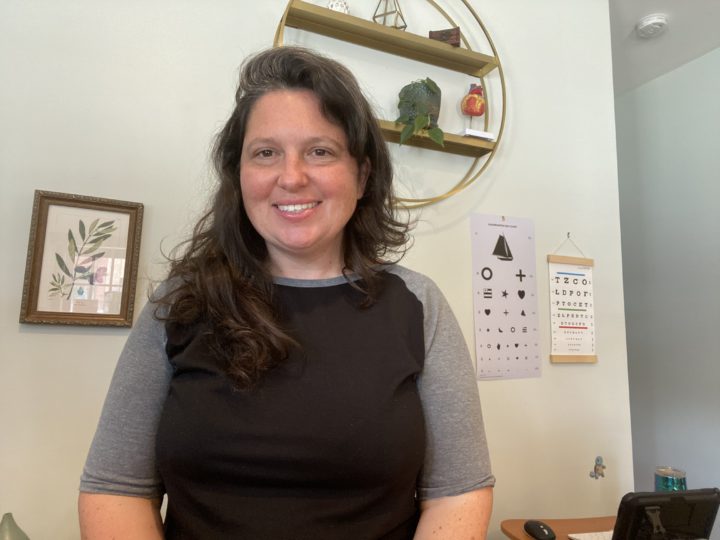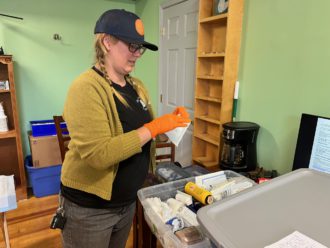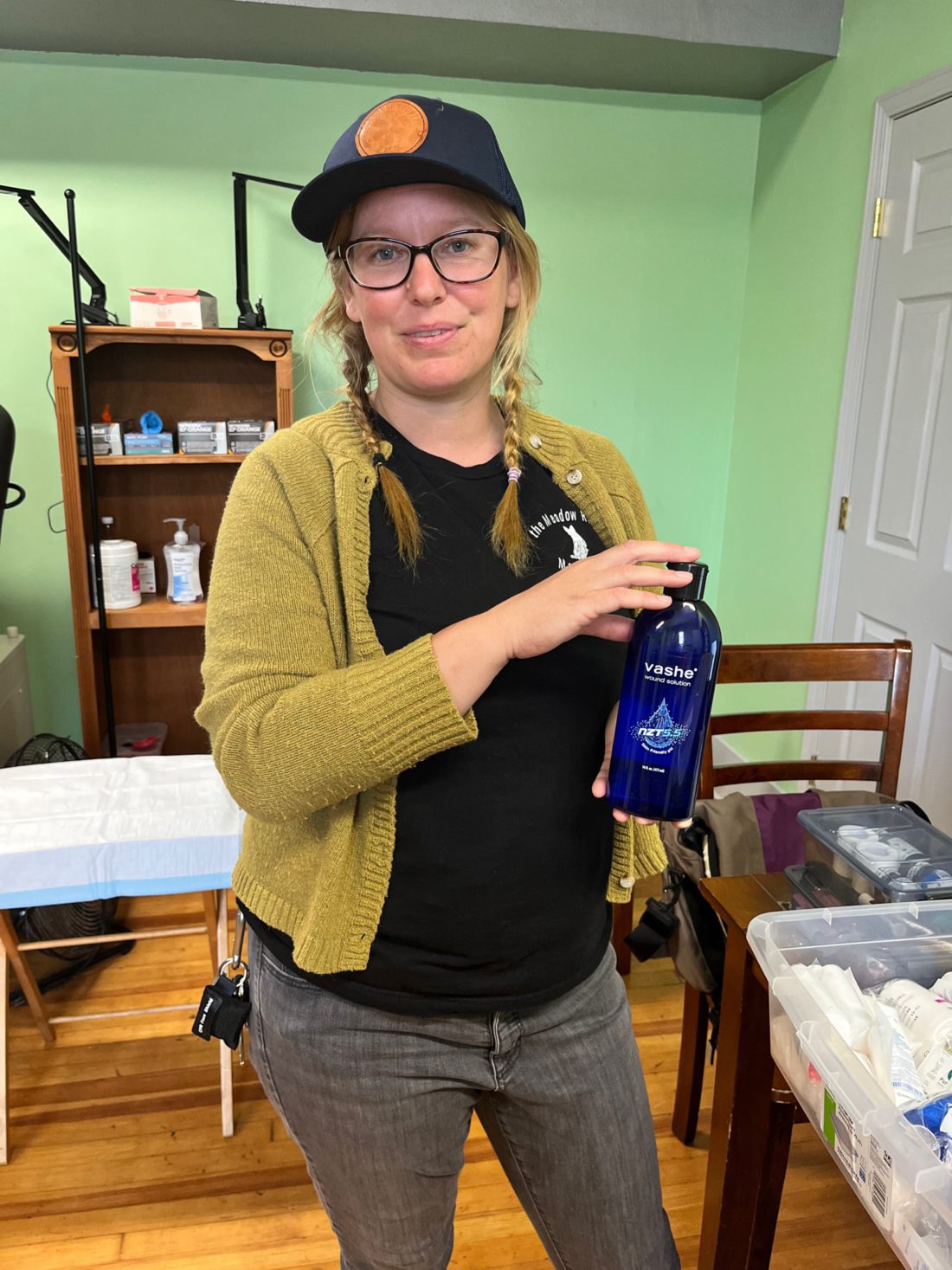Haywood Street Congregation bustles with activity on a Wednesday morning in July. The backyard smells of grills firing up for a lunchtime cookout. People chat or rest in pews in the central hall, away from the heat. In a church office, Buncombe County’s Emergency Medical Services Mobile Community Outreach Team sets up for the day. Erika Harrison, a licensed practical nurse with BCEMS, unpacks several 30-quart plastic containers of medical supplies for wound care.
On Wednesdays, Harrison has a standing date at Haywood Street Congregation to clean and bandage wounds and replace bandages. Many of these wounds resulted from intravenous drug use; surgeries, trauma or amputations have caused others. Many of her patients at the church, and clients who are served by the MCOT daily, are unhoused.
Volunteers or workers for Steady Collective, BeLoved Asheville and Holler Harm Reduction — all mobile groups addressing needs of the unhoused and people who use drugs — have provided wound care in the community for many years. EMTs and paramedics with BCEMS have also regularly treated wounds throughout the county. MCOT began offering wound care at Haywood Street Congregation in November, and Harrison, who has a certification in wound care, joined in May.
MCOT is currently a pilot program within BCEMS, says Harrison. It’s composed of four EMTs, three community health workers and her. The team is one of several mobile medical units addressing wound care through street medicine, also called backpack medicine, in Buncombe County. The Street Medicine Institute, a national nonprofit, describes it as “health and social services developed specifically to address the unique needs and circumstances of the unsheltered homeless delivered directly to them in their own environment.”
At Haywood Street Congregation, Harrison’s consultation room — which appears to be an empty office — has a medical exam table and a curtain for patient privacy. However, the vibe is “very communal,” she explains. There are several chairs and a minifridge filled with water. Patients chat with her and volunteer Tim Gastrock. Approachability is paramount, as many patients had negative health care interactions in the past, she says. “People with wounds are often very scared, very vulnerable,” says Harrison. She’s dedicated to building rapport with patients, which she says takes “time and space and a lack of urgency, without having an agenda.”
Two types of wounds
There are two general categories for wound care, says Shannon O’Conner, a family nurse practitioner and co-founder of WNC Healing Collaborative, an independent family practice in Marshall. Both categories can be influenced by social determinants of health, such as economic stability or access to nutritious foods.

One category is for chronic, hard-to-heal wounds that have failed to go through the normal process of healing. Patients may have “complex medical histories and problems,” like diabetes, poor lower-extremity blood flow or an infection, O’Conner explains. “Their bodies just physically cannot make the skin they need to heal the wound.” She recalls one patient who has been tending to the same nonhealing wound for 40 years.
These wounds can be stuck in an inflammatory phase. Inflammation is the body’s normal response to healing a wound, but nonstop inflammation can cause poor circulation or swelling. O’Conner also manages “a lot of post-surgical site infections — I’ll see folks sometimes six weeks after surgery when their wounds just aren’t healing along the normal progression.” When patients’ wounds aren’t healing, she provides advanced dressings and skin grafts that serve as wound coverings.
The other category of care is for wounds caused by physical trauma or intravenous drugs, which O’Conner calls community wound care. Patients in this category of need may be younger and have fewer comorbidities or chronic diseases. Their wounds may be newer and less complicated to manage. But IV drug use may cause multiple skin breaks on various locations on the body. Some wounds, like those caused by xylazine, or “tranq,” can cause sores and abscesses that kill the tissue and then require amputation.
Prevention of infections is a crucial part of wound care and decreases the need for antibiotic use. Regularly accessing antibiotics, fulfilling prescriptions and taking medication can be difficult for people who are unhoused or experiencing physical or mental health issues.
What wound care entails
Wound care, to hear its practitioners describe it, has a simple goal: Keep the wound clean.
That may sound straightforward, but Melissa Weiss, who works part time doing wound care for Steady Collective, says until recently, health care providers would leave wounds to dry out. Protocol has changed, she says. “What I tell people is keep your wound covered and moist with medication.” Weiss is certified as an EMT, and in addition to Steady Collective, she works for the medic team at Salvage Station.
Cleaning a wound means excising damaged tissue and removing debris. Wound care practitioners say they use Hibiclens, an antibacterial cleanser often used in hospital settings, and Vashe wound solution, as well as cotton-tipped applicators and nitrile synthetic exam gloves. When Harrison is meeting people out on the street, she carries these supplies in a backpack.
Wound care practitioners also make choices about bandages and gauze depending on what’s available, and what’s accessible due to the cost. Silver foam dressing is considered top notch, but it’s more expensive than other dressings. Weiss also uses Tegaderm, a transparent film dressing often applied to people’s skin after receiving a tattoo.
Availability of supplies may also be affected by the season. Bandage adhesives are less reliable in the summer, when people who live outside are sweating. During warmer months, Weiss says she often uses Coband self-adhesive bandage, a colorful, stretchy material commonly used after a blood draw.

Barriers and stigma
Basic wound care — say, bandaging a sliced finger — can be done at home with clean water and bandages. More complex wounds can be managed at clinics, emergency rooms or dedicated wound care facilities, like the six that Mission Health operates throughout Western North Carolina.
But patients who use drugs or who have used drugs in the past can feel stigmatized in traditional health care settings. Unhoused people can also lack consistent access to clean water and clothing, let alone costly supplies like stretchy gauze or antiseptic skin cleanser.
“You’re going to avoid situations where people are rude to you,” says Weiss of people who have used drugs. She’s lost many friends to overdoses, she says, and originally began working in wound care as a volunteer for Steady Collective. “If I noticed a Band-Aid or noticed a wound, I would say, supercasually, ‘Hey, do you want me to look at that?’” Most people were receptive to her help, she says. Some didn’t want anyone looking at their wounds but would take supplies.
“Wounds have a stigma, and sometimes people feel shame around their wounds,” Weiss explains. “They feel gross or hideous.” The trusting relationship she has developed goes a long way, she says, because “the act of wound care is pretty intimate.”
Currently, there is no indoor clinic space for wound care in Asheville (the setup at Haywood Street Congregation isn’t officially permitted to call itself a clinic). While some people who work in street medicine will go directly to individuals living on the street, or staying in encampments, Steady Collective operates out of a decommissioned Red Cross ambulance that travels around the county.
“Doing this outside of the ambulance is really challenging — because of the weather, because of the publicity of it, because you’re on the street, so it’s hard to make a clean area for your supplies,” Weiss explains. “And people also deserve privacy when they’re getting medical care.”
Ounce of prevention
When people seek health care at Haywood Street Congregation, BCEMS can use the opportunity to link them to other resources as well. On the Wednesday when Xpress visited, one man came to Harrison needing clean socks; he left with two pairs. Another man sought a way to clean his feet, which itched. Harrison advised him not to use a wet sanitizer but to keep them dry, and gave him talc powder to use. One of BCEMS’ community paramedics was available in a nearby room to share information about medication-assisted treatment or mental health treatment.
Each expert who spoke with Xpress emphasized the importance of education, particularly among IV drug users. O’Conner notes that follow-ups are not guaranteed; she may only have one opportunity to demonstrate to someone how to clean a wound and change a dressing, and share supplies that could prevent infection or a wound reopening. Such interventions could prevent emergency room visits in the short term or nonhealing wounds — essentially, open sores — in the long term, she explains.
In addition to more primary care access, Weiss would like to see more compassion overall for people who use or have used drugs. All people “deserve respect and integrity in their life,” she says. “And access to lifesaving medical care.”
Do you have more to add to this story? Contact the author at jwakeman [at] mountainx.com.



A very needed service for this underserved population.